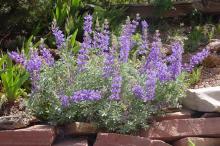Another plant that has flown the coop! For years this graced a raised bed and produced a ton of seed (its progeny are now thriving in OTHER people's gardens) and no matter what I do I can't seem to get this to grow again here or anywhere else in my garden. For five or six years it would bloom magnificently through spring, and in a few days in June shoot hundreds of seed all over the place. Would a single one of these have germinated nearby and perpetuated the show? No way.
Lupinus argenteus is somewhat similar, and is even rhizomatous. It has ramped over a large slope in the Dryland Garden at Denver Botanic Gardens, blooming on and off all summer. Staff dig chunks of this like bearded iris and plunk them elsewhere, where they take off and grow just fine.
But this most silky leaved and beautiful of Western lupines is a tad more fussy. Isn't that the way of the world?
Comments
Re: A super lupine
Is it Lupinus sericeus? (Do I get a prize if that's right, or just another karma point? ;D)
Watch out, people can select "smite" too! I wonder if that should've been "smitten". I don't want to be "smote". I have asked the web master why the term "smite" in an option in the forum.
Re: A super lupine
Yikes, I'm bracing myself to be smote... or possibly smitten. :o (Knowing how lousy I am at identifying lupins!)
EDIT: Errr, you mean I got a karma point because someone clicked the "applause" button? (Oh my, I'm touched! :-* Whoever you are, thank you! Hey, it can't be unclicked, can it?) And what is the current exchange rate in karma points, anyway? Is it worth my while to shoot for high ratings? (You know, the promise of a few seeds sent in plain brown paper envelopes across the border... nudge, nudge, wink, wink.... ??)
Re: A super lupine
You can tell I was rushing to fill up all those blasted new generic categories posted by our otherwise esteemed webmaster (grrrrrrrr): not only Nature abhors vacuums! And in my hurry I neglected to let you know that this Lupine is L. albifrons--which looks so xeric and silvery and all, but the only place I've seen it in nature is in the Cascade mountains growing almost solid beneath conifer woodlands. I think that had to be an anomaly.
Re: A super lupine
That's a beauty!
Here's another nice lupin, Lupinus argenteus, a local native, and the one that Panayoti mentioned above.
And... I was completely floored to discover, years ago, that it spreads by bright yellow, ropy rhizomatous roots (as Panayoti noted) - what incredible behavior for a lupin! Then I spent the next few years trying to figure out which species it was. :( (It's very odd that one has to hunt high and low to find any description that includes a mention of the rhizomes, which I'd have thought, in my naivete, was a pretty darned interesting, if not defining, characteristic!) Are there other lupins with rhizomatous roots?
Anyway, it's an attractive, long-blooming plant. Despite the rhizomes, I have not found it to be invasive... although it is always a little uncertain where the next one will pop up!
Re: A super lupine
Looks just like the L. argenteus at DBG: must seek out pictures...
Yes, the rooting is distinctive. And it tolerates a completely unwatered garden here in Denver (which is saying a lot)...
Re: A super lupine
I have ignored this illuminous lupinous discussion till now but have been smitten by the talk and pictures! You know, the common, not native lupins here are L. nootkatensis, L. perennis, L. polyphyllus and L. x regalis which have spread many places as garden escapees and also sown along the roads. Now they are unwanted!
Nobody has yet forbidden L. argenteus or albifrons. Can I be so bold as to ask for seed or have I to wait for the seed list?
Re: A super lupine
That's a beauty!
Here's another nice lupin, Lupinus argenteus, a local native, and the one that Panayoti mentioned above.
And... I was completely floored to discover, years ago, that it spreads by bright yellow, ropy rhizomatous roots (as Panayoti noted) - what incredible behavior for a lupin! Then I spent the next few years trying to figure out which species it was. :( (It's very odd that one has to hunt high and low to find any description that includes a mention of the rhizomes, which I'd have thought, in my naivete, was a pretty darned interesting, if not defining, characteristic!) Are there other lupins with rhizomatous roots?
Anyway, it's an attractive, long-blooming plant. Despite the rhizomes, I have not found it to be invasive... although it is always a little uncertain where the next one will pop up!
Lori, please keep me in mind next year if you happen to get seed on this and happen to remember ;) I have not run into any of our native lupines, wonder how far north they get...
Re: A super lupine
I really love these American lupins (legumes in general are not half bad!) and have tried quite a few from seed, but need to try harder. L.albifrons has been a great success, though not too long lived, and the form that has been very good on the sand bed is the dwarf and prostrate collinus. Previous plants did seed for me but deeply resented being transplanted. L. argentatus is one for me to try. There are some great species in South America too (John Watson occasionally collected seed) but I doubt any are in cultivation now.


Is it Lupinus sericeus? (Do I get a prize if that's right, or just another karma point? ;D)